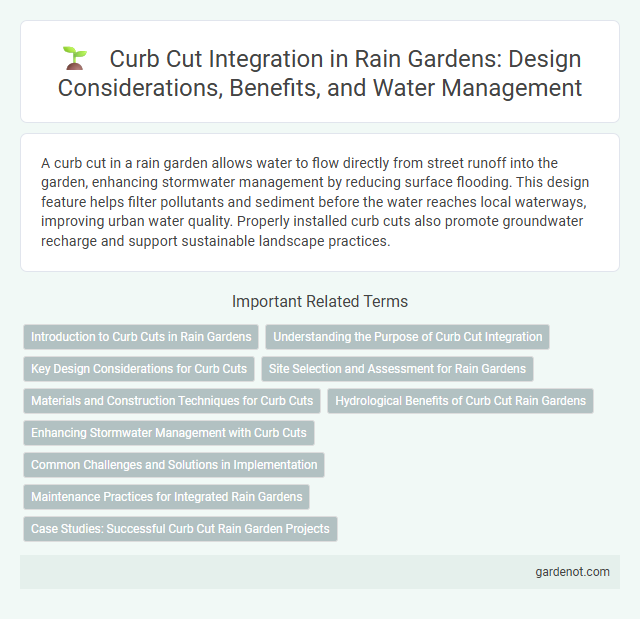A curb cut in a rain garden allows water to flow directly from street runoff into the garden, enhancing stormwater management by reducing surface flooding. This design feature helps filter pollutants and sediment before the water reaches local waterways, improving urban water quality. Properly installed curb cuts also promote groundwater recharge and support sustainable landscape practices.
Introduction to Curb Cuts in Rain Gardens
Curb cuts are intentional openings in sidewalks or curbs designed to direct stormwater runoff into rain gardens, enhancing urban water management. These cuts facilitate the natural infiltration of rainwater, reducing surface flooding and improving groundwater recharge. Properly engineered curb cuts optimize rain garden efficiency by channeling water flow while preventing debris and sediment from clogging the system.
Understanding the Purpose of Curb Cut Integration
A curb cut in rain garden design creates a functional opening in the curb to direct stormwater runoff from streets into the rain garden for natural infiltration and filtration. This integration effectively reduces urban runoff volume, mitigates flooding risks, and enhances water quality by allowing pollutants to settle out before water reenters the ecosystem. Properly designed curb cuts ensure efficient water flow management and support sustainable urban drainage systems.
Key Design Considerations for Curb Cuts
Curb cuts in rain gardens must be carefully designed to ensure efficient water flow and prevent erosion, with dimensions tailored to local rainfall patterns and urban runoff volumes. Proper slope and alignment are critical to direct stormwater into the garden without causing overflow or damage to surrounding infrastructure. Material selection for curb cuts should prioritize durability and permeability to support water infiltration and minimize debris blockage.
Site Selection and Assessment for Rain Gardens
Curb cuts are essential for directing stormwater runoff into rain gardens, requiring careful site selection to identify areas with adequate slope and soil permeability. Assessing the proximity to downspouts, driveway edges, and street gutters ensures efficient water capture and minimizes flood risk. Evaluating surrounding infrastructure and vegetation helps optimize curb cut placement to maximize infiltration and pollutant filtration in the rain garden system.
Materials and Construction Techniques for Curb Cuts
Curb cuts in rain gardens commonly utilize durable materials such as reinforced concrete, precast curbs, or asphalt with beveled edges to ensure structural integrity and effective water flow. Construction techniques involve precise grading and compaction to maintain proper slope and prevent erosion while integrating permeable pavements or infiltration trenches to facilitate stormwater infiltration. Proper installation includes creating a smooth transition from roadway to garden bed, enhancing both functionality and longevity of the rain garden system.
Hydrological Benefits of Curb Cut Rain Gardens
Curb cut rain gardens enhance urban stormwater management by directing runoff from streets into vegetated infiltration areas, reducing surface water flow and mitigating flood risks. These gardens improve groundwater recharge and decrease pollutant loads by filtering contaminants through soil and plant root systems before water enters drainage networks. By intercepting rainwater at curb cuts, they effectively reduce peak flow volumes and promote sustainable hydrological cycles in urban environments.
Enhancing Stormwater Management with Curb Cuts
Curb cuts improve stormwater management by directing runoff from impervious surfaces into rain gardens, reducing surface flooding and promoting groundwater recharge. These designed openings enable efficient capture and filtration of rainwater, minimizing pollutants before they reach storm drains. Integrating curb cuts in urban planning enhances sustainable water management by supporting natural infiltration processes.
Common Challenges and Solutions in Implementation
Curb cut installation in rain gardens often faces challenges such as improper slope design leading to poor water infiltration and potential street flooding. Ensuring accurate grading, using permeable materials, and regular maintenance of debris buildup provide effective solutions to enhance curb cut functionality. Collaboration with local utilities and adherence to municipal stormwater guidelines further mitigate risks associated with curb cut implementation.
Maintenance Practices for Integrated Rain Gardens
Curb cuts channel stormwater runoff directly into rain gardens, enhancing water infiltration and reducing urban flooding. Regular maintenance includes inspecting curb cuts for debris buildup, ensuring unobstructed water flow, and repairing erosion or sediment accumulation. Proper upkeep of curb cuts supports the efficiency and longevity of integrated rain garden systems in managing stormwater.
Case Studies: Successful Curb Cut Rain Garden Projects
Curb cut rain garden projects in Portland, Oregon, demonstrate effective stormwater management by redirecting runoff into vegetated basins, reducing urban flooding and improving water quality. In Chicago, Illinois, strategic placement of curb cuts combined with native plantings has enhanced local biodiversity while mitigating pollution in Lake Michigan. These case studies highlight the scalability of curb cut rain gardens in diverse urban environments, promoting sustainable infrastructure and community resilience.
Curb cut Infographic

 gardenot.com
gardenot.com